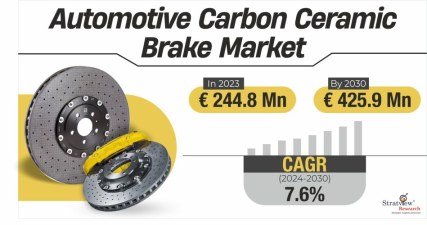Market Dynamics and Drivers of Automotive Carbon Ceramic Brakes: A Comprehensive Analysis
The automotive carbon ceramic brake market is experiencing significant growth, driven by increasing demand for high-performance braking systems, advancements in automotive technology, and rising consumer preference for safety and durability. This analysis delves into the key dynamics and drivers shaping the market’s trajectory.
According to Stratview Research, the automotive carbon ceramic brakes market was estimated at Euro 244.8 million in 2023 and is likely to grow at a CAGR of 7.6% during 2024-2030 to reach Euro 425.9 million in 2030.

Market Dynamics
Carbon ceramic brakes, known for their exceptional performance under extreme conditions, are gaining traction across various vehicle segments, particularly luxury cars and sports vehicles. These brakes offer superior heat resistance, reduced brake fade, and a longer lifespan compared to traditional braking systems.
However, the high cost of production and limited adoption in mid-range and budget vehicles pose challenges to market expansion. Manufacturers are exploring cost-reduction strategies and technological innovations to make these systems more accessible. Additionally, stringent environmental regulations are pushing automakers to adopt lightweight components, further driving the integration of carbon ceramic brakes.
Key Drivers of Market Growth
1. Demand for High-Performance Vehicles: The increasing popularity of high-performance sports cars and luxury vehicles is a significant driver. Carbon ceramic brakes enhance the driving experience by providing better stopping power and ensuring safety at high speeds, making them a preferred choice for premium automakers.
2. Rising Safety Concerns: Consumer awareness regarding vehicle safety has escalated, compelling manufacturers to incorporate advanced braking systems. The growing emphasis on reducing road accidents has spurred the adoption of reliable and efficient braking solutions like carbon ceramic brakes.
3. Technological Advancements: Continuous innovations in materials and manufacturing processes have improved the performance and affordability of carbon ceramic brakes. Research and development in composite materials are expected to further boost the market, enabling wider adoption.
4. Regulatory Push for Lightweight Vehicles: Governments worldwide are enforcing regulations to reduce vehicle emissions and improve fuel efficiency. The lightweight nature of carbon ceramic brakes aligns with these goals, making them an attractive option for automakers aiming to comply with environmental standards.
Future Outlook
The automotive carbon ceramic brake market is poised for robust growth, particularly in emerging markets where disposable incomes are rising, and automotive sectors are expanding. Collaborative efforts between manufacturers and material suppliers are expected to address cost barriers, unlocking new opportunities.
In conclusion, the market dynamics of automotive carbon ceramic brakes are driven by a blend of technological advancements, consumer demand for safety, and regulatory frameworks. As innovation continues, these brakes are likely to become a standard feature in a broader range of vehicles.